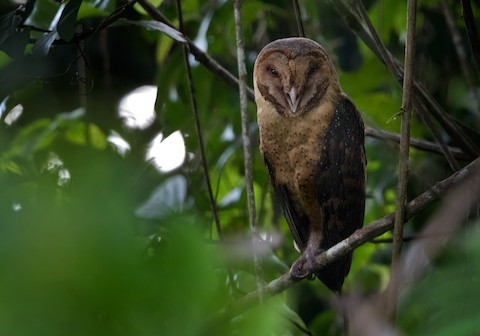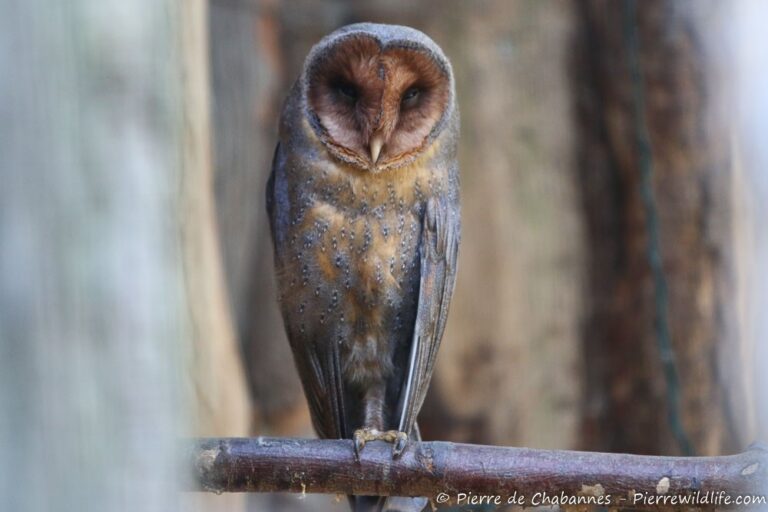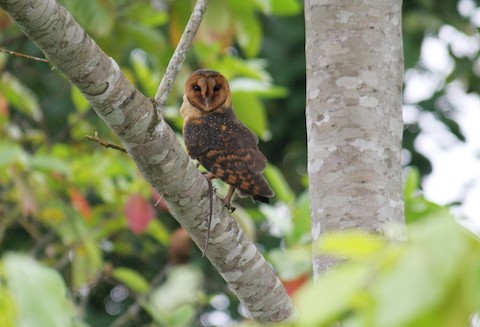Birdfinding.info ⇒ A little-known São Tomé endemic that appears to be fairly common in its limited range. It has been reported islandwide but most often from the interior highlands and southern coastal areas, especially around São João dos Angolares.
São Tomé Barn Owl
Tyto thomensis
Endemic to São Tomé, where it apparently occurs in most habitats, including settled areas.
Identification
A medium-sized, dark, heavily spotted barn owl. The only barn owl known from São Tomé.

São Tomé Barn Owl. (São João dos Angolares, São Tomé; August 30, 2023.) © Daniel Danckwerts
The upperparts are mostly gray or gray-brown with white spots on the wing coverts and back.
The underparts are mostly orangish-buffy with dark spots.

São Tomé Barn Owl. (São João dos Angolares, São Tomé; September 17, 2017.) © Lars Petersson
The facial disk typically appears pinkish-brown or vinaceous with a golden-brown rim.

São Tomé Barn Owl, captive individual with extensively gray plumage. © Pierre de Chabannes
Some individuals have gray plumage nearly throughout, except for the facial disk.

São Tomé Barn Owl, captive individual with extensively gray plumage. (August 2017.) © Vision
Notes
Monotypic species. Traditionally classified as a subspecies of the Barn Owl (T. alba), but more recently treated as a subspecies of the Western Barn Owl (T. alba) by several taxonomic authorities.
Provisionally treated as a separate species here because both recent guidebooks to the owls of the world, König and Weick (2008) and Mikkola (2013), recognize it as such.
References
Aliabadian, M., N. Alaei-Kakhki, O. Mirshamsi, V. Nijman, and A. Roulin. 2016. Phylogeny, biogeography, and diversification of barn owls (Aves: Strigiformes). Biological Journal of the Linnean Society 119:904-918.
BirdLife International. 2019. Tyto alba (amended version of 2016 assessment). The IUCN Red List of Threatened Species 2019: e.T22688504A155542941. https://dx.doi.org/10.2305/IUCN.UK.2019-3.RLTS.T22688504A155542941.en. (Accessed December 6, 2023.)
eBird. 2023. eBird: An online database of bird distribution and abundance. Cornell Lab of Ornithology, Ithaca, N.Y. http://www.ebird.org. (Accessed December 6, 2023.)
iNaturalist. 2023. https://www.inaturalist.org/. (Accessed December 6, 2023.)
König, C., and F. Weick. 2008. Owls of the World (Second Edition). Yale University Press.
Mikkola, H. 2013. Owls of the World: A Photographic Guide (Second Edition). Firefly Books, London.
Xeno-Canto. 2023. Western Barn Owl – Tyto alba. https://xeno-canto.org/species/Tyto-alba. (Accessed December 6, 2023.)
